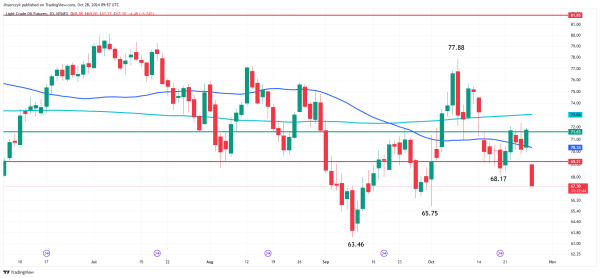Oil News: Crude Futures Plunge Below Key Support on Weak Demand Outlook
Light Crude Oil Futures Drop Sharply on Demand Concerns
Light crude oil futures saw a significant drop on Monday, breaching critical technical support levels as they dipped below a long-term retracement zone at $69.21. The downside momentum also pushed prices past last week’s low of $68.17, leaving $65.75—the October 1 bottom—as the next major support. Technically, the 50-day moving average at $70.34 and the 200-day moving average at $73.04, which control the intermediate and long-term trends, respectively, now serve as substantial resistance levels for any recovery attempts.

At 10:18 GMT, Light Crude Oil futures are trading $67.28, down $4.50 or -6.27%.
Middle East Conflict Fails to Sustain Oil’s Risk Premium
Despite ongoing conflict in the Middle East, the crude market has interpreted recent events as a step toward de-escalation, causing the regional risk premium to fade. Over the weekend, Israel launched airstrikes against missile sites in Iran, which Iranian authorities claimed resulted in limited damage. Israel’s choice not to target Iran’s nuclear or oil infrastructure, combined with a restrained response from Tehran, has led traders to perceive a lower likelihood of an immediate escalation that would impact oil supplies.
Consequently, Brent crude futures dropped approximately 5.3% in early Asian trading, hitting a low of $71.99 per barrel before stabilizing around $72.73. The easing of geopolitical tension has shifted the market’s attention back to underlying demand concerns and broader economic factors that continue to weigh on oil prices.
Demand Weakness in Asia and OPEC’s Production Strategy
The focus has shifted to weak global demand, particularly from Asia, as a primary driver of falling crude prices. OPEC+ has already postponed an output increase initially planned for October, rescheduling it for December to avoid further depressing prices. The coalition now aims to add 180,000 barrels per day (bpd) in 2025, gradually increasing supply to stabilize prices.
However, the anticipated demand growth from Asia, especially China, has not materialized as strongly as anticipated. China’s crude imports have fallen by 350,000 bpd in the first nine months of 2024 compared to 2023, with October’s import volume likely to follow a similar trend. As China continues focusing on internal economic stimulus and electric vehicle expansion, analysts caution that the measures may not significantly drive up crude oil demand.
Outlook: Bearish Near-Term Bias on Weak Demand Signals
In the short term, oil prices appear pressured by weak demand signals from key markets, especially China, along with muted impacts from the Middle East conflict. With major technical resistance levels and lackluster demand weighing on the market, traders should anticipate a bearish outlook unless economic conditions in Asia improve or geopolitical tensions intensify in a way that directly threatens oil supply infrastructure. The near-term risk remains tilted toward further downside in crude prices as supply concerns recede and demand growth fails to keep pace with expectations.